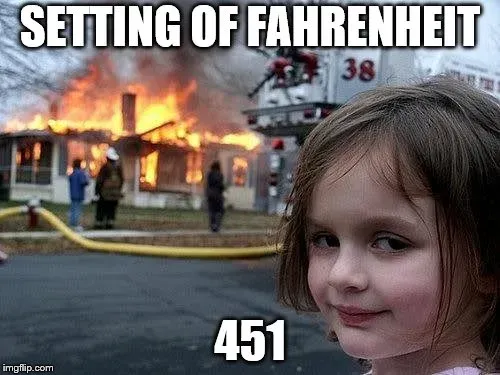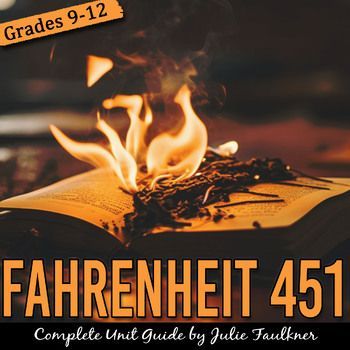A Movie Review of HBO’s Fahrenheit 451
From a High School English Teacher
Since this phase represents the end of the process and everything that occurs after the paper has been completed, I like to call this phase the “after party.” It really works, too, if you think about because the accomplishment of writing should be celebrated!
1. Characters/Characterization
Not everything about the characters was 100% spot on, but that is to be expected, I suppose. So what works and what doesn’t?
- Beatty – Captain Beatty is our resident manipulative, maniacal manager of the fire. He’s the villain through and through, loving to control the narrative and burn anything that gets in his way. Right. Right? Well, maybe not. Beatty’s ambiguity is what makes him so compelling, confusing, and complex. In my opinion, the film does a nice job of painting a picture of Beatty of which Bradbury would approve.
- Faber/Granger – These fiction-loving fellas aren’t named characters in the film, but their archetype is certainly present. In fact, they play a huge role in the film in terms of propelling the conflict. In the novel, the bulk of the conflict is driven by Montag’s internal struggle, but the film really hinges on both the person v. person and person v. society conflict with the “Eels” to move the plot. I suppose that’s a pretty decent substitution.
- Montag – I’m not sure anybody can really live up to our Guy Montag. He’s always the hardest one to pinpoint and agree upon when we do our exercise in class of picking the actors/actresses. Everyone just always has a different idea of who he should be. He fumbles through most of the book trying to figure himself out, so maybe that’s why he is so hard to pinpoint. HBO’s Montag experiences a similar struggle, but I am still not quite satisfied for some reason. Montag the confused – yes, I can get on board with that. Montag the superstar – nah, I’ll pass on that interpretation. Maybe my hopes were too high. That said, I would give Michael B. Jordan a B+.
- Ms. Blake – What a powerful scene. Glad she – and it – was included. Enough said.
- Mildred – Initially, I was bothered by the fact that Mildred wasn’t included. The more I think on it, though, I can accept the choice. In the movie, she wasn’t just an obsessed robotic tv watcher, she WAS the robot. Clever. In the text, Bradbury needed a vessel to paint the picture society’s bad behaviors, etc. On the big screen and with today’s special effects, it is possible to just make it evident in other ways. Figuratively, too, it speaks to the whole idea of how little she actually contributed anything to Montag or society at all and how truly forgettable she was. Gone like a freight train (puns are intended), gone like yesterday. Wait, who was Millie again?
- Clarisse – Clarisse provides the most mystery in the book, and the kids always love her. Bradbury is even quoted as saying he is Clarisse in the book: full of wonder and curiosity. It’s with Clarisse that the film falls of the wagon in the characters/characterization category. Clarisse is supposed to be light and airy and a picture of innocence, but in the film, she is too dark and brooding for my liking. And then there’s the whole spark between Montag and Clarisse.
Not. My. Favorite. My students always think they’ve “picked up” on something between Montag and Clarisse when they read the scenes with her, and I always stress how incorrect
that reading is. Clarisse is a catalyst for Montag’s path toward the truth. In that that way – and only in that way – might she serve as a femme fatale, luring him to the light. Am I surprised “Hollywood” used her character as a way to provide some on-screen romance? No, but it’s just textually inaccurate. As an aside here: My students didn’t like her in the film either.
2. Setting
So much of what Bradbury penned was futuristic – and dare I say prophetic – in the 1950s. Today, though, just about every bit of it has come to fruition, and what hasn’t can be computer generated for the movies. I was pleased to see the infusion of the large screens; they are, in fact, everywhere: in homes, in streets, and even on the skyscrapers. Bradbury’s biggest fear was the detrimental effects of people’s over consumption of and obsession with television. The TVs are ever present and “large and in charge.” However, I’m not so certain the intended dystopian city that Bradbury envisioned really seemed “all that bad” in HBO’s version. The setting, for me, kinda fizzled out.
3. OMNIS
This is a massive change from the book, but it may just be this detail that shows us – 2018 watchers of the film – how close we might actually be to Bradbury’s dystopian future. OMNIS holds every piece of literature, art, and history in a DNA strand, preserving the long forgotten culture that the firemen tried to erase. While there are underground members of society, like Granger and his “railroad” crew that memorize entire books in order to preserve them, it is this OMNIS that they work to protect and preserve. Once the OMNIS is introduced into the plot, it becomes the major source of the conflict, as it is the focus of the firemen’s revenge. The twist is that this DNA strand has been implanted in a bird. After some thought, I decided I might be satisfied with this change as I see connections with it and the prominent role of the Phoenix in the novel. OMNIS becomes a symbol of hope in a bleak, literature-loathing society that hints at the emergence of a better future. It’s a reminder that it doesn’t matter how much “graffiti” (books) the firemen decide to burn, there’s still hope out there for a free-thinking future — much like the Phoenix that is burned but rises again.
4. Theme
Ultimately, Bradbury wants readers to put themselves in the characters’ shoes: What role would you have played in this dystopian universe: perpetuator, bystander, fighter? Would you see the truth like Montag, or continue to fumble your way through the pursuit for emptiness happiness like Mildred. Would you fight to manipulate and cover the truth like Beatty or use truth to lead others to it like Faber or Granger? It is the growth from within that he wants – that really can bring the change that this culture needs. Truth, knowledge, morality — all erased and replaced with what people see rather than what they think. The movie does a good job of making that clear — maybe a little too clear (some points didn’t leave much to the imagination), but in order to bridge the gap to “modern audiences,” I can see the need. Maybe that’s a tad ironic, and telling, in and of itself. Nonetheless, tons of lines from the book are woven throughout, and I enjoyed hearing Bradbury’s voice.
5. The Ending
Bradbury’s ending is open, or so many of my students say, and most really do hate that. I always pose the question to them, though, Is it really open ended? Throughout the entire book, Bradbury wants readers to realize that the value of books is to provide information, but more importantly to make people think. On one hand, the open ending forces readers to do that. On the other hand, maybe the ending so open at all. Montag did figure out his purpose, and if you read it that way, then what else was there? Either way, the movie definitely provides us with Bahrani’s idea of what he thought should be Montag’s purpose: keep the “books” alive. But die? I could see a case for his death in the book, but die at the hand of Beatty. That idea should be torched. In the movie, the books “rise from the ashes” to live on and that offers some hope, but having Beatty kill Montag gives the villain way too much power, and erases hope that the books — and future — will really be safe. To link in another once “hot” film, President Snow said, “Hope, it is the only thing stronger than fear. A little hope is effective, a lot of hope is dangerous. A spark is fine, as long as it’s contained.” (Sidebar: Does anybody else see the HG connections? I can’t unsee it.) If Bahrani intended to remove that hope, that’s dark and maybe it’s a little too dark. But perhaps that’s just me trying to look on the bright side.
Final thoughts: Is it appropriate for class? HBO rated the film TV-MA for violence and language. That said, just about any novel we pick up is going to have violence and language or worse. I am not a fan of it either, and I don’t want to convey that at all. Otherwise, it’s pretty benign. All in all, I did think it was time well spent showing it to my students. It brought up so many conversations; and we really did decide that the book is better. It doesn’t get much better for my little English-teacher heart. In my school, anytime we show a film, we have to get our principal to approve it. So, I did that, and I wrote a parent letter and created a set of questions student would answer during the viewing. He was fine with that, and I had zero parents ask for an alternative assignment. I do have older students, but if you cover your bases this way you should be fine. (See my Teacher Talk Video on Facebook here about dealing with novels with difficult content.)
Get the letter I drafted and the questions HERE for free!
If you teach Fahrenheit 451 as a novel unit, stop over to my teacherspayteachers store and take a look at my complete unit plan. Also, did you enjoy the memes above? I have to brag on my students. Those were all their original work, and I have to admit, I laughed out loud at most of them.
Love this content?
Sign up for my email newsletter with more tips, ideas, success stories, and freebies!


















